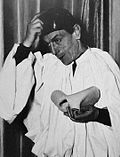Commedia dell'arte
Commedia Dell'arte Media
Eduardo De Filippo as Pulcinella, a character from the commedia dell'arte
Commedia dell'arte troupe I Gelosi performing, by Hieronymus Francken I, c. 1590
Pulcinella, drawn by Maurice Sand
Harlequin in a 19th-century Italian print
Commedia dell'Arte Troupe on a Wagon in a Town Square by Jan Miel (1640)
Statues of Pantalone and Harlequin, two stock characters from the commedia dell'arte, in the Museo Teatrale alla Scala, Milan
Jean-Antoine Watteau (1684–1721), commedia dell'arte player of Pierrot, c. 1718–19, identified as "Gilles". Louvre, Paris.
Harlequin and Colombina. Paint by Giovanni Domenico Ferretti.
Commedia dell'arte is a form of improvisational theatre. It began in Italy in the 16th century. The form continued to be popular during the 17th century and is still popular today.
The title is difficult to translate. A close translation is “comedy of craft”. This is shortened from commedia dell’arte all’improvviso, or “comedy of improvisation”.
The plays of Commedia dell'arte were often performed by a small group of actors who traveled around and performed in town squares. The actors would pass a hat around for people to put money in.
The earliest known group was in Padua in 1545. By the end of the seventeenth century, there were several troupes (group of actors). These included the Gelosi, Confidenti, and Fedeli. Some troupes were popular at courts outside of Italy. In France, images from the commedia became a favorite theme of well-known artists.
The actors often wore masks. The stories were often about people being cunning. Hunger, love and money were important in the stories. There were several characters who appeared in many of the stories. These are called "stock characters". Examples of stock characters from Commedia dell'arte are: Harlequin, Pantalone, Arlecchino, Colombina, Pulcinella, Pierrot, Scaramuccia.
Commedia dell'arte had a lot of influence on theatre plays in many countries. Punch and Judy shows, popular with children in Britain and other countries, are similar to Commedia dell'arte. They also have stock characters: Punch, Judy, the crocodile, the policeman etc.









